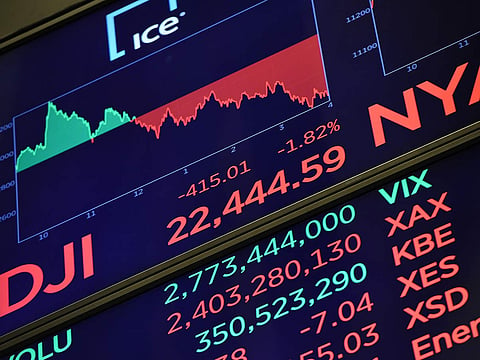US stocks suffer worst week in seven years
US stocks sank to a 17-month low to close out their worst week since August 2011

US stocks sank to a 17-month low to close out their worst week since August 2011, with every sector losing ground and heavy selling in technology shares driving the Nasdaq indexes into a bear market. Treasuries edged higher.
Heavy volume sparked by the simultaneous expiration of futures and options lashed stocks that have been under pressure all week from concern over rising interest rates and the threat of slower global growth. Renewed personnel turmoil in the White House and the growing likelihood of a government shutdown added to investor anxiety before the holidays.
Dovish comments from a Fed official gave an early boost to the S&P 500, but renewed selling in some of the bull market's biggest winners sent the index lower. It's now down over 17 percent from its record.
The Nasdaq indexes fared even worse, each sliding more than 2 percent Friday to bring routs since summer records past 20 percent. Every member of the FANG cohort lost more than 2.5 percent, while Twitter plunged more than 6 percent. The Cboe Volatility Index, known as the "fear gauge," rose above 30 to hit a 10-month high. The dollar advanced as China signaled an easier monetary policy, and bonds retreated across Europe.
"It's a convergence of various factors, from global growth, to quantitative tightening concerns, as well as political risk in the U.S. and across the globe," said Chad Morganlander, portfolio manager at Washington Crossing Advisors. "It's like 'Wow, man.' It's unbelievable - it's the polar opposite of what you had in 2017. Investors don't necessarily need to dive into the pool until you see some of these various issues subside."
The MSCI Asia Pacific Index dropped for the fourth session in six. The Stoxx Europe 600 Index finished little changed.
Treasuries rose, but European bonds fell ahead of the Christmas break. The dollar climbed against the yuan and most major currencies after China's top policy makers said "significant" cuts to taxes and fees will be enacted in 2019, while signaling an easier monetary policy stance. The moves are the latest by leaders in world's second-biggest economy as they grapple with a domestic slowdown and a trade war with America.
Elsewhere, orders placed with U.S. factories for business equipment fell in November, missing forecasts for an increase and adding to signs that demand is slowing amid risks from the trade war with China.
Sign up for the Daily Briefing
Get the latest news and updates straight to your inbox



